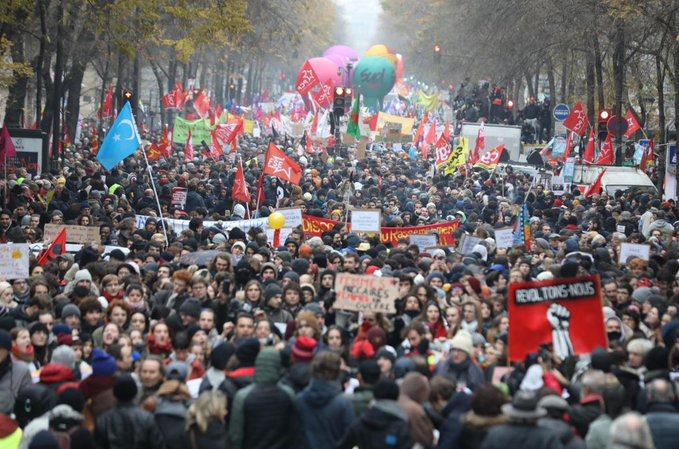Yesterday’s general strike against Macron’s pension reform saw a “convergence of struggles” from across French society. According to the CGT (the trade union federation at the head of the strike), 1.5 million people took part in the demonstrations, which would make this the biggest movement since the battle against Alain Juppé’s package of attacks in 1995. The spirit of the gilets jaunes can be felt on the streets, where (despite the limitations of their leadership) the workers are directing their fury, not just against the pension reform, but the government as a whole.
The police and the unions have provided conflicting figures for the turnout in different parts of the country, making it difficult to get a completely accurate picture. For instance, in Marseille, the CGT claimed there were 150,000 demonstrators – six-times higher than the official police estimate. The authorities tend to downplay the scale of demonstrations, and looking at the images on social media, it seems the unions’ numbers are closer to the truth. What is not in doubt is the turnout everywhere was significantly higher than in recent years.
The police counted 33,000 in Toulouse, 20,000 in Bordeaux, 19,000 in Nantes, 15,000 in Clermont-Ferrand, 13,000 in Lille, Rouen and Grenoble; and several thousand in Tours, Rennes, Brest, Saint-Etienne, Bayonne, Pau, Strasbourg, Perpignan, Limoges, Saint-Nazaire and Caen. If we assume a similar scale of dishonesty applies to these numbers as to the turnout in Marseille, the national figure is truly outstanding. There was also a massive mobilisation in Versailles, where strikes closed down, not only the train station, but the Palace!
Unbelievable.
— Joshua Potash ? (@JoshuaPotash) December 5, 2019
Millions of French workers are on strike today.
This is Toulouse ??
pic.twitter.com/xCQRykjjge
Convergence of struggles
Transport workers formed the backbone of the strike. There was an almost total shutdown of public transport, with the state rail group (SNCF) estimating that just one-in-10 high-speed and intercity trains were running yesterday. 90 percent of regional services were similarly shut down. In Paris, the Metro stations were deserted as the rail workers down tools. International services like the Eurostar were also crippled, and Air France was forced to cancel 30 percent of internal and short-haul international flights following a mass walkout by air traffic controllers.
Pensée émue pour BFMTV à la recherche d'images choc des parisiens en train de se battre dans les transports ?? #GreveGenerale #grevedu5decembre pic.twitter.com/BX5OptwXgW
— Gaby (@Gab_799) December 5, 2019
Other layers of public sector workers came out in force, particularly teachers. Hundreds of schools were closed as around 70 percent of primary and 60 percent of secondary school teachers went on strike, many of whom were joined on the demonstrations by their pupils. Health workers were also a visible presence. Although they were obliged to maintain a minimum service, they participated strongly across the country, and there is footage circulating on social media of fleets of ambulances blockading the main roads in Paris.
The fist of the French state (already bloodied by its repression of the gilets jaunes) came down hard on the demonstrations. 6,000 riot police lined the route of the main column in Paris, which was marching from Gare du Nord to the east of the city, and by the afternoon there had been over 70 arrests. As the day wore on, the gendarmes across the country became more aggressive, firing tear gas and launching dreaded “stingball” canisters at the crowds: the vicious riot-suppression weapon that has cost many gilets jaunes their fingers and eyes. In spite of this, the demonstrators were mostly peaceful, with only a few clashes and instances of vandalism breaking out.
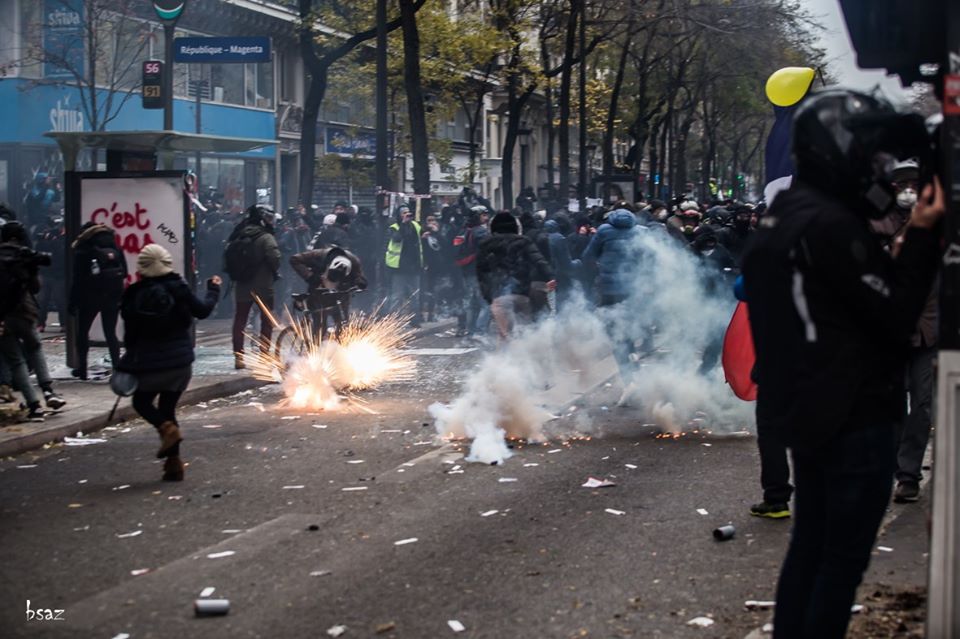 Stingball grenades and teargas have been deployed against protesters / Image: fair use
Stingball grenades and teargas have been deployed against protesters / Image: fair use
The firefighters played an especially heroic role. Two months ago, they held a demonstration over pay and working conditions, which was violently put down by the police. This has had a strong impact on their consciousness. Despite clashes between firefighters and the police in Lille, they were mostly a disciplined force, coming out as an organised bloc in Avignon, Toulon, Rennes and Rouen, raising their hands to show they were not looking for a fight. But that doesn't mean they were passive.
In the capital, the firefighters faced down the CRS (riot police), after the main column was blocked on Boulevard Magenta and again at the Place de la République. The crowd was hit with volley after volley of teargas, making the air unbreathable, after which the firefighters covered their mouths with facemasks and marched at the head of the column to drive the police back, breaking the blockade and allowing the column to proceed. All the while, the crowd was chanting: “Macron, démisson!” – the main slogan of the gilets jaunes.
Image forte et lourde de sens ! Des dizaines de pompiers en première ligne font reculer la police et mettent fin à une nasse du cortège de tête. #retraites #grevedu5decembre #5decembre #GreveGenerale #GiletsJaunes #greve5decembre #paris pic.twitter.com/BdlDJEvZDK
— Cerveaux non disponibles (@CerveauxNon) December 5, 2019
While the public sector walk-out was widespread, it was a different story for private sector workers. Again, there is limited information available, but it seems turnout here was limited to a small minority. For instance, it has been reported that only five percent of workers at the Renault factory in Flins took part, despite a call for participation from the unions.
However, some key private sector industries were affected. For instance, petroleum workers in the oil refineries have in recent years emerged as a very radical section of the working class. Seven out of the eight major French refineries were on strike yesterday, including those operated by Total in Donges (Loire-Atlantique), Gonfreville-l'Orcher (Seine-Maritime), Grandpuits (Seine-et-Marne), Feyzin (Lyon metropolis) and La Mède (Bouches-du-Rhône).
Moreover, there were disruptions in other sections of the supply chain. For instance, strikers blockaded 12 of Total’s 200 warehouses. Dockers have also been taking part, going on strike at the oil ports of Fos and Le Havre, with rumblings in Portes-les-Valence (Drôme), Puget-sur-Argens (Var) and Saint-Jean-de-Braye (Loiret).
While they have dwindled to a rump, the gilets jaunes were dotted throughout the demonstrations – shoulder to shoulder with the trade unions. They have been filmed lifting toll booths in St-Arnoult, allowing traffic to pass without paying the fare; and small groups of between 200 and 300 protesters have been reviving the gilets jaunes’ signature tactic of blockading roundabouts. The gilets noirs (the movement of undocumented migrants inspired by the methods of the yellow vests) were also out on the demonstrations, offering general solidarity with the strike and raising their own demands for papers to work legally in the country.
♦️Péage de St-Arnoult [78]♦️
— Gilets Jaunes Paris #6Décembre (@GiletsJaunesGo) December 5, 2019
Opération « péage gratuit » ce jeudi matin pour les #GiletsJaunes d’IDF.#Grèvedu5Décembre #5Décembrehttps://t.co/t3UkfGids1 pic.twitter.com/p1iHvTNx4S
Although youth participation was widespread, the students did not come out as an organised bloc. IMT comrades raised slogans for student-worker solidarity and bringing down the government at student assemblies in Toulouse and Paris, which were well received. However, there is a mood of disaffection with the official leaders of the student movement, who have turned student assemblies on campus into toothless talking shops. There has also been some confusion and demoralisation after a string of defeats inflicted against the student movement in the recent period. As a result, while assemblies of 400-500 have been raised on a number of campuses, this figure is far smaller than during the gilets jaunes movement at its height.
This is not to suggest the youth are not supportive of the strike – quite the contrary. Students increasingly sense the dynamic of struggle is in the streets, amongst the working class, rather than seeing themselves as a separate faction. As a result, rather than debating endlessly with their peers on campus, thousands of young people have simply thrown themselves into the demonstrations, alongside the workers.
The strike rolled over into today, resulting in 350km of traffic jams in the Paris area, and most of the public transport networks will remain closed over the weekend. Although schools are officially open again, many lessons are still being disrupted. Despite the chaos, and fervent attempts by the Macron government to drive a wedge between the general population and public sector workers (whom Macron and the press have accused of enjoying unfair “privileges”), public support for the strike is very high. A poll found that 69 percent of the French support the movement.
The masses have correctly drawn the conclusion that Macron’s attack on the public sector and pensions represents part of a general policy of attacks on workers. If it is not resisted, Macron will continue to decimate working conditions and public services at the behest of his capitalist masters. As Arnaud, a 30 year-old sales manager commented:
"If people really knew how this reform would impact them, they would all be out in the street."
Problem of leadership
Today, the CGT convened a general summit, involving FO, Solidaire, FSU and four youth organisations, to debate how to proceed. It was subsequently announced that another inter-professional strike will be held next Tuesday, after a scheduled response from the Macron government. In the meantime, general assemblies of SNCF and RATP workers had already voted by large majorities to continue their action until at least Monday.
Despite emphasising the need to “generalise the strikes in all the workplaces”, there is an inescapable sense that the CGT leadership is lagging behind events. A clear contradiction is emerging between the strategy and outlook of the union tops, and the rank and file. The former are turning all their fire on the pensions reform. The latter are attacking the general policy of the Macron government and calling for its overthrow. It is clear that the union leadership was spooked by the experience of the gilets jaunes movement, which happened entirely outside of its control and erupted into a struggle of insurrectionary proportions.
In the last decade, where the crisis of French capitalism has made genuine concessions by the government an impossibility, the strategy of the union leadership has followed a certain pattern. The government would carry out attacks on the working class, who would put pressure on the unions to lead a fightback. The unions would then call several “days of action” (rarely strikes), which would be well-attended and militant, but accomplish nothing more than letting off steam. Once the movement was exhausted, people would return to work – empty handed and demoralised – and the government would go ahead with its cuts.
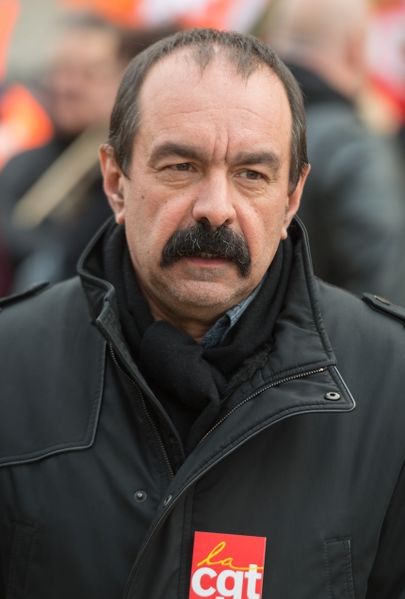 The union tops are trying to reign in the movement / Image: Mister NK42
The union tops are trying to reign in the movement / Image: Mister NK42
The capitalist crisis has undermined the old system of social partnership, in which the union bureaucracy would serve as the official ‘mediator’ between the government and the working class. In order to maintain their privileged positions, the bureaucrats have adapted themselves and now simply play the role of putting the brakes on the working class, and helping to steer their rising anger down safe channels.
The gilets jaunes movement marked the end of this strategy. It was led by the most-squeezed and depressed layers of French society, and became a rallying cry for a working class that had become utterly fed up with the stultifying role of their traditional organisations. That the gilets jaunes emerged entirely outside of the official structures of the unions (whose leaders treated it with loathing and suspicion) was entirely unsurprising, as was their scepticism towards the traditional mass organisations. Despite the efforts of rank-and-file unionists to build links of solidarity with the yellow vests, this mutual hostility was never fully overcome.
Today, despite the movement ebbing (under the hammer blows of the state, and given the lack of a revolutionary leadership) the impact of the gilets jaunes on French society has been profound. There have been two main effects. Firstly, the masses have learned from the gilets jaunes that the way to win concessions is through direct action. In forcing a u-turn on Macron’s regressive fuel tax, the yellow vests accomplished more in a few weeks than the mass organisations had won in 10 years. As Isabelle Jarrivet, a 52-year-old town hall administrator in Paris commented:
“The gilets jaunes protests got people thinking and talking more about politics and people determined not to let things pass. You can feel a defiant mood in the air.”
In this sense, although the gilets jaunes have receded, they are stronger than ever. For many protesters on the ground, the sentiment today is: “we are all the gilets jaunes.”
The second effect of the gilets jaunes was to focus all the disparate struggles in French society against this-or-that counter-reform into a general fight against the entire policy of Macron’s government of the rich. This has really rattled the union tops. No longer able to divert the masses’ rage into useless “days of action” (which the government does not fear in the least), they have been forced by pressure from below to organise a proper strike, which has paralysed the country and put Macron back onto the defensive.
The problem, from bureaucrats’ point of view, is that – given the depth of anger on the streets, and the lessons learned over the experience of the gilets jaunes movement – this strike has the potential to get rapidly out of hand.
It is notable that the union leaders have deliberately been coy about the turnout in different sectors and parts of the country. The truth is, despite what they say, they don’t really want a “convergence of struggles” that draws in wide layers of French society. They have made no serious effort to coordinate the national struggle, or provide it with any political leadership, programme, objectives or perspectives.
It is clear from the slogans and mood on the streets that the masses don’t just want the pension reform cancelled, they want Macron out. Another insurrectionary movement from below – especially one with a clear, working-class character – would put the privileged position of the union bureaucracy in jeopardy. The tops simply want to leverage the strike to force further negotiations with the government (as is clear in statements from CGT General Secretary, Philippe Martinez). As such, they are doing their utmost to focus exclusively on the pension reform, avoiding any slogans against the government as a whole and refusing to provide leadership to the general offensive against Macron.
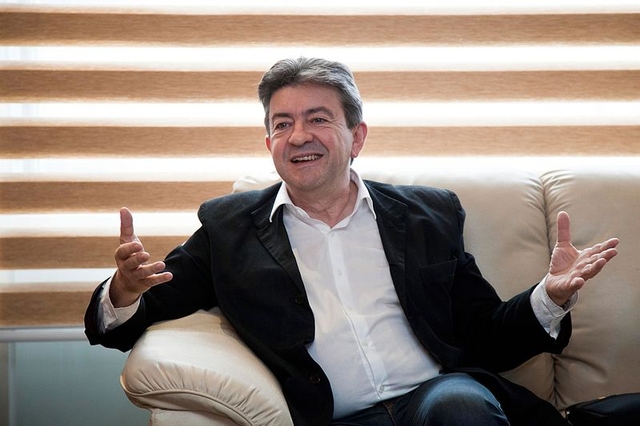 Melenchon's vacillations have cost him and FI ground / Image: public domain
Melenchon's vacillations have cost him and FI ground / Image: public domain
The pension reform is a reflection of a deeper need by crisis-ridden French capitalism to squeeze the working class. Macron’s whole policy is an expression of this. The battle against the pension reform therefore ultimately necessitates a reckoning with the Macron regime as a whole. The CGT leaders’ bankrupt strategy is designed simply to contain and divert the masses’ insurrectionary energy down a cul-de-sac.
Unfortunately, Mélenchon and France Insoumise have adopted the same position, emphasising the fight against the pension reform in isolation. This is a far cry from the radicalism of Mélenchon’s stance during the height of the gilets jaunes movement, where he endorsed their demand to overthrow Macron and even dissolve the National Assembly. This reflects the crisis gripping France Insoumise, whose aversion to establishing proper party structures, in favour of remaining an amorphous “social movement”, has hobbled the organisation. After a bruising result during the recent European elections, this wounded self-confidence precipitated a rightward turn, with Mélenchon making overtures to the Greens (who are no better than the Social Democrats) to form a coalition government in future.
This is precisely the wrong strategy at this juncture. If Mélenchon could recapture some of his radical spirit from two or three years ago, put France Insoumise on a proper, organised basis, and come out with bold slogans aimed at bringing down Macron, he could fill the void left by the mass organisations and connect with the insurrectionary mood. As it is, France Insoumise’s dire straits were reflected during the march in Paris, where they constituted a bloc of 200 at the very back of a column over 200,000 strong.
Spirit of the gilets jaunes lives on!
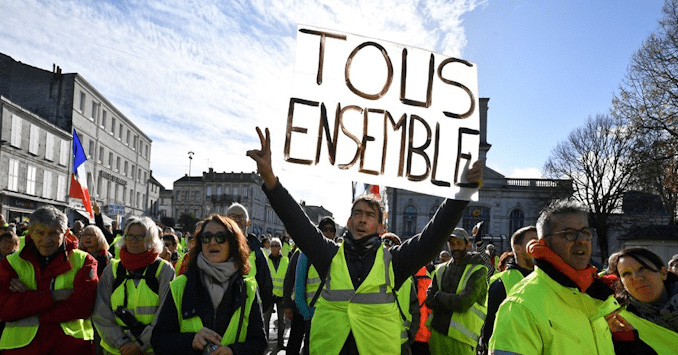 Everyone is a gilet jaune! / Image fair use
Everyone is a gilet jaune! / Image fair use
In stark contrast to the passivity and obsession with “negotiations” at the top, the base of the union movement is bold and dynamic. The workers are already holding general assemblies of their own initiative, and making efforts to extend and strengthen the strike. This represents the road forward.
The main danger at this point is of the transport workers at the vanguard of the strike becoming isolated. The government can probably just about endure an indefinite transport strike if other sectors recede or fail to come out. If it becomes desperate, the government might even enter into separate negotiations with the heads of the transport unions to protect workers in this industry from the brunt of the pension reforms, in order to drive a wedge between them and the rest of the working class.
As mentioned, the union leaders are making no efforts to seriously build the strike or bring out private sector workers, beyond passively “calling” for action. The workers in struggle must turn their general assemblies into the basis of a revolutionary leadership, elected from their own ranks. Rather than simply inviting wider layers of the working class to join the fight, this leadership must politically explain to the workers that all their grievances ultimately stem from the rotten Macron government, acting at the behest of the equally rotten capitalist system. What is needed, therefore, is a programme of action: a continuous general strike to finish what the gilets jaunes started, and put an end to Macron.
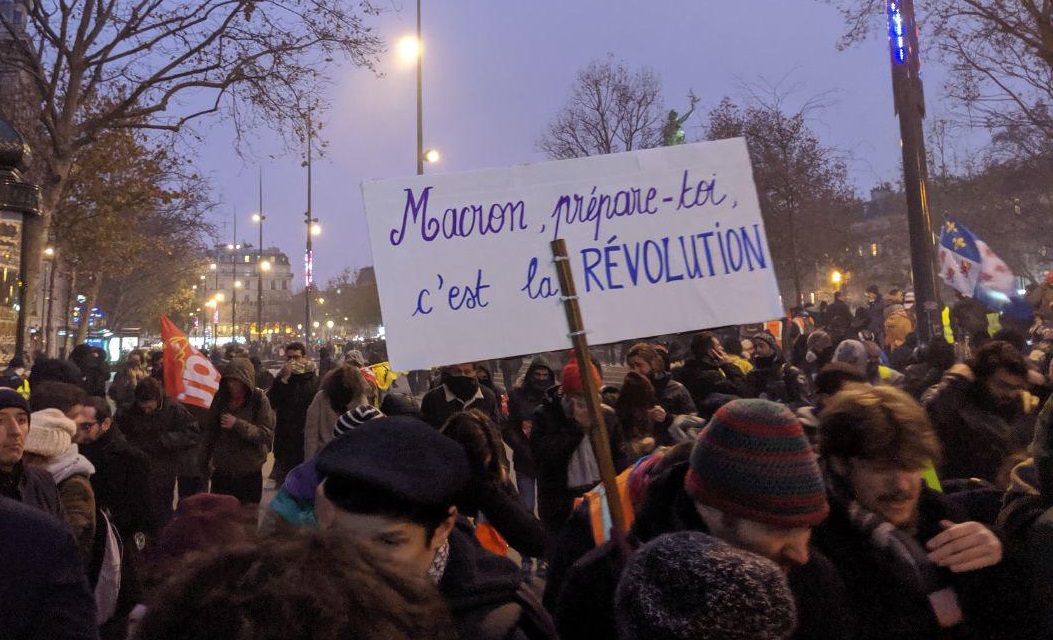 We are witnessing the next step towards a burgeoning French Revolution / Image: fair use
We are witnessing the next step towards a burgeoning French Revolution / Image: fair use
It is clear that the gilets jaunes movement was the first chapter in a new era of class struggle in France, one in which millions of workers have come to realise their potential power. The yellow vests were limited by their heterogeneous class character, and the lack of clear methods of class struggle. Now, there is the potential for a movement on a qualitatively higher level, rooted in the working class. If the workers’ methods of struggle are combined with the courage and direct action of the gilets jaunes, no manoeuvre by either Macron or the union tops will be able to hold the movement back. What we are witnessing is the next step towards a burgeoning French Revolution.

